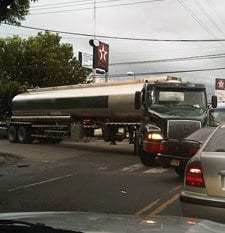
Last month we reported that more trucks would be on the road because of the approaching holiday season. In fact, data just in for October show that truck deliveries to stores and warehouse hubs are way up—at a rate of 90% over last year. This is due in large part to lower gas prices, which make trucking an economical option for bringing goods to market.
HDT Truckinginfo reports that trailer orders are at an all-time high. They note that not only large trucking fleets are out in force, but even most medium and small operators are busy. October 2014 data from the Department of Transportation’s Federal Motor Carrier Safety Administration (FCMSA) shows that for-hire carriers have about three times the number of fatalities as do private trucking companies.
In plain terms this can mean an increase in fatalities, especially during the run-up to Christmas, when the demand for trucking services is at its peak. Companies now are expanding their delivery capacity by hiring smaller trucking contractors, and these are the main generators of truck crash fatalities.
We ask you to be more vigilant when driving and to review our safety information for avoiding truck accidents.
Here again are some key points to help you “steer clear” of truck accidents:
Drive at speeds appropriate to laws as well as road conditions. Slow down in wet weather and/or low visibility.
Put even more stopping distance between yourself and the truck ahead of you when roads are wet.
Remember that a truck operates, moves and brakes differently from a car:
- Stay 20-25 car lengths behind a truck to maintain a safe distance away from the truck. This is especially true when going uphill—if the truck driver slips back due to a gear downshift, you want to be far enough behind to avoid a collision.
- Be cautious at turns; avoid turning in parallel to large trucks. Large trucks have a wider turning radius than cars and you don’t want to be “pinched”.
- The driver cannot always see you, especially in a small car, but also because the truck has blind spots for which the driver cannot compensate. Whereas you would check your mirrors or look around, the rear of the truck is an invisible zone for the truck driver, as is the join area between the cab and the trailer. “A good rule of thumb is: if you can’t see the driver in the truck’s side mirrors, the driver can’t see you.”
Take a look at this short and informative clip about trucking safety and the danger of trucks’ blind spots:
Jay Stillman
jay@jstillman.com
615-244-2111






